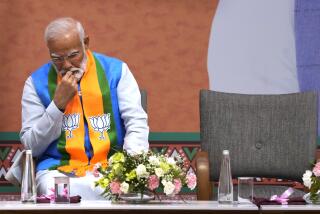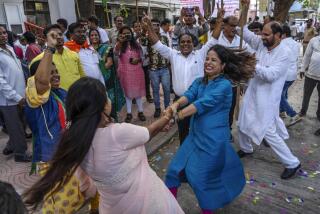India’s Leader Shows Staying Power : Asia: Prime Minister Rao, once dismissed as a lightweight, marks three years in power and ticks off achievements during rally.
- Share via
NEW DELHI — Under a broiling sun, Prime Minister P. V. Narasimha Rao, once dismissed as a gentle political elder without ambition, celebrated the accomplishments of his first three years in office Thursday with a huge open-air rally.
When he assumed power, he said, India had been plunged into “darkness” by the brutal assassination of Rajiv Gandhi, the former prime minister. “Nobody knew what to do,” Rao recalled. “The country was divided, both socially and politically.”
Since then, Rao told a parched crowd at Delhi’s sprawling Red Fort, it is as if India had been refreshed by the life-giving rains of the monsoon.
The most clement weather has not yet arrived, Rao said, speaking in terms even the simplest farmer could understand. “But you will find that there has been an overall improvement in the situation, I mean of the 900-million population and the country,” he maintained.
Thursday’s event was an apotheosis of sorts for the soft-spoken former foreign, home and defense minister who became India’s ninth head of government on June 21, 1991, and who, as leader of the party that Jawaharlal Nehru, Indira Gandhi and Rajiv Gandhi also belonged to, seemed then not to be in the same class.
But the South Indian’s staying power and shrewd mastery of political infighting have impressed many. It was only in December that the defection of some opposition lawmakers gave Rao and his Congress-I Party a majority in the Lok Sabha, Parliament’s lower house.
“Now, we have a majority government, and there is stability in the country,” Rao, 73, said in his rambling speech, which lasted for more than an hour and a half as his audience sweated.
The venue was one carefully chosen for its links to great events--the Mogul-built fort of red sandstone where Nehru, another Congress prime minister, proclaimed the independence of India in 1947.
Not all has been rosy for Rao of late, however. As he and his finance minister, Manmohan Singh, try to scrap decades of bureaucratic control over the economy, India’s inflation rate has crept back into double-digit territory.
The police and armed forces have proven incapable of defeating the Muslim insurrection in the state of Jammu and Kashmir. Relations with neighboring Pakistan, which also claims Kashmir as its own, are the worst in years.
The prime minister suffered a humiliating reversal on the domestic scene last month when he and Congress failed to marshal the necessary two-thirds majority in Parliament to reduce the powers of the ferociously independent election commissioner, T. N. Seshan.
Special trains and buses brought people from throughout India to Thursday’s rally, which was organized by the All-India Congress-I Committee. The sandy ground by the fort’s parapets was transformed into a glittering tapestry of India’s varied populace as turbaned and barefoot Punjabis, small men clad in white loincloths from the southern state of Kerala and matrons in saris from Delhi’s most exclusive neighborhoods mingled by the tens of thousands.
Congress leaders predicted that 1 million people would turn out, but attendance appeared nowhere near that. Many in the crowd obviously didn’t understand Hindi, the language Rao used in his speech, and thousands streamed toward the exits as he talked.
Much of New Delhi was decked out in the saffron, green and white that are the Congress’--and India’s--colors.
Milking the legacy of the party that led the independence struggle for all it was worth, organizers had set up the same sort of giant cutouts used to advertise movies, this time showing Rao with past prime ministers and with Mohandas K. Gandhi, who was once Congress president.
At traffic circles, cutouts of a smiling Rajiv Gandhi, who was killed May 21, 1991, by a suicide bomber waved eerily at motorists.
It was Gandhi’s assassination, and the refusal of his Italian-born widow, Sonia, to succeed him as party president during national elections that led Congress leaders to ask Rao to take the job. Rao then seemed to many a safe stopgap solution; it was assumed that one of the party’s regional powerbrokers would take control later.
But Rao proved as skillful in neutralizing his rivals inside Congress as in blunting the challenge mounted by the main opposition group, the Hindu nationalist Bharatiya Janata Party, which was routed in last autumn’s state elections.
When Rao appeared in his booth of bulletproof glass shortly after noon, many people had already been in the sun for hours. As the temperature neared 100, some fainted.
Rao said somewhat apologetically that, if the rally had been held last month on the actual anniversary date, it would have been even hotter. To wait till the cool weather of autumn, he said, would be to risk accusations that the event was nothing but a vote-getting ploy for the upcoming elections in 10 states.
Not that the Congress leader didn’t make a delicate play for voters’ support. Rao asked Indians to devote a “year of thinking” to the next elections for the national Parliament.
S. Gopal and Amit Sharma of The Times’ New Delhi Bureau contributed to this report.
More to Read
Sign up for Essential California
The most important California stories and recommendations in your inbox every morning.
You may occasionally receive promotional content from the Los Angeles Times.













